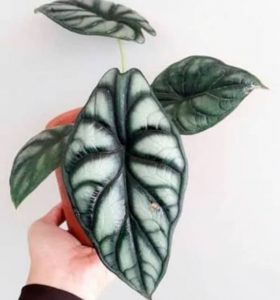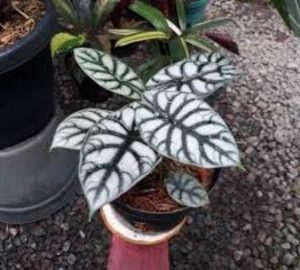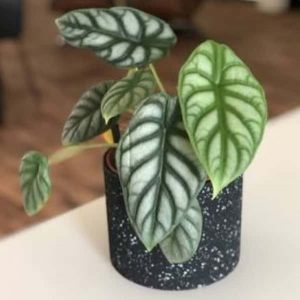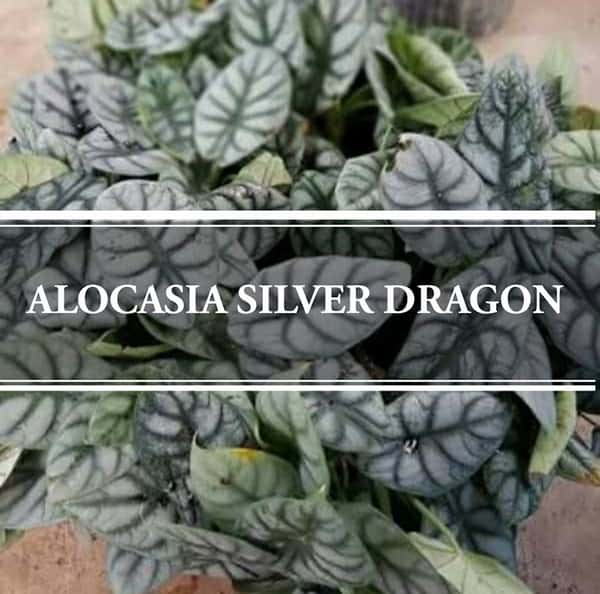Who doesn’t like the Jewel Alocasias with their attractive foliage? We are discussing a famous and mesmerizing variety of the Aroid, the thick-leaf jewel Alocasia Baginda. The Alocasia Silver Dragon is native to South-East Asia. It can survive pretty well both indoors and outdoors. This is one of the most compact growing plants of its genus and remains under 0.5 meters in height. Consequently, it becomes an excellent choice for terrariums and indoor terrestrial pots.
The light to silvery-green, heart-shaped leaves with dark-green ribbed venation make it look nothing lesser than a mesmerizing gift of nature. In this article, we are going to share all you need to know about the low-maintenance, Alocasia Silver Dragon Plant along with its care and propagation.
Alocasia Silver Dragon Classification
Family: Araceae
Genus: Alocasia
Species: A.baginda
Variety: Silver Dragon
Genus Alocasia
Alocasia is a genus comprising more than 70 unique perennial flowering plants. Prominent features of this genus include large-sized attractive foliage and underground rhizomes as the rooting system. Alocasia is cultivated and hybridized on a large scale. This results in a large number of unique cultivars and varieties. These include the famous Alocasia amazonica and the gigantic Alocasia macrorrhizos.
Species A. Baginda
Alocasia Baginda is an award winner plant famous for both indoor and outdoor decoration. The attractive, velvety, emerald green leaves with darker venation make it look one of its kind. The plant can reach up to a height of 1 to 2 meters. Besides the Silver Scale, the other varieties of the Baginda plant include Alocasia pink dragon and Alocasia reginula Black Velvet.
Alocasia Silver Dragon Common Names
- Elephant Ear ‘Silver Dragon’.
- The African Gray Mask.
Features of the Alocasia Silver Dragon Plant

Height and Structure
- The height of the plant is highly dependent on the space available. The average height and spread of an indoor plant is around 50cm (0.5 meters).
- Long petioles support the leaves. A number of petioles join at the base to form the plant body.
- The plant body doesn’t like to expend much.
Leaves
- The length of a mature leaf is around 15 cm with a width of about 5 to 8 cm.
Air-purification
In addition to its beauty, it will purify the air of its surroundings. Isn’t it a good package for indoor ornamentation?
Toxicity
All the Alocasias are highly toxic for both plants and animals. They possess no.4 level toxicity. Ingestion may lead to severe reactions and ulceration in the throat and oesophagus. Thus, keep the kids and pets strictly away from your Alocasia Silver.
Dormancy
Just like the majority of Alocasias, the plant shows slow growth in winter. Moreover, it may shed some or all of the leaves as well. This is popularly known as the stage of dormancy. The plant is alive and just ‘sleeping’. Your jewel Silver Dragon Alocasia will start flourishing as soon as the spring arrives.
Interestingly, you can minimize the dormancy by keeping the plant in its optimum requirements, especially the temperature and sunlight.
Alocasia Silver Dragon Care

Water Requirement
Let us share a basic watering strategy. Water the plant thoroughly and wait for the soil to get dry before you water again. The frequency depends upon the season and the temperature. In summer, you need to water about three times a week. While in winter, once a week seems to be enough. Importantly, wet feet, wet foliage, and soggy soil are strictly intolerable for the Alocasia silver. Thus, always avoid over-watering.
Sunlight Requirement
Bright indirect light is ideal for the plant. However, in fierce summers, the plant does well in semi-shade. An east or north-facing window is the ideal place to place your plant. It is important to mention here that direct sunlight is unsuitable for the plant.
Thus, avoid keeping the plant in direct sun, especially for long hours.
Temperature Requirement
The ideal temperature range for the Alocasias is 55 to 80 °F. Just like other thick-leafed jewel Alocasias, the Silver Dragon Alocasias have minimum tolerance towards cold. Thus, it is necessary to transfer the plant inside as soon as the fall arrives. This is highly important for the colder zones.
Soil Requirement
The Silver Dragon Alocasia likes free-draining soil. You can use any commercially available well-drained house plant mix. Sandy and rock soils don’t go well along with the Alocasia plants.
Humidity Requirement
Just like other members of its genus, Silver Dragon is a humidity lover. About 80% of the moisture is essential for the plant. You can adjust the humidity and increase the moisture level by different measures. Add a pebble-water tray under the plant pot. However, make sure the pot stands on the pebbles and roots don’t sit in the water.
Secondly, you can introduce a humidifier in the room or group the plant to increase the humidity supply.
Misting is another common method to increase humidity. However, this is not suitable for the thick leaf Alocasias. As it leads to different sort of plant diseases including rot and fungus.
Fertilizer Requirement
Jewel Alocasia plants love the added nutrition in their growing season. You can use any domestic plant fertilizer according to the directions on the pack. Avoid low-quality and cheap fertilizers. As they accumulate in the soil-forming crystals. These crystals are harmful to plants.
The plants don’t need any extra nutrition in fall and winter.
Pot requirement
Check for the drainage holes before planting.
Growth Zones
Growth Zone 9 to 11 is suitable for the outdoor growth of the plant. While, if you want indoor growth, the plant can do well in all USDA Zones 4 to 11.
Alocasia Silver Dragon Propagation

The best method to propagate this plant is by clump or division.
Season
The season of spring and the early summer are ideal for propagation. You can also try up until the end of the summer. Howbeit, in the colder days when the plant is in dormancy, propagation does not become successful. Division does not turn out to be successful during winter.
Method
- Loose the soil around the base of a healthy plant. Gently, take the rhizome out of the soil.
- Take a sterilized knife and cut about 1/3rd of the rhizome.
- Now, plant both of the rhizome parts in the desired places.
- Provide the new rhizome with a warm, humid place with indirect sunlight of medium intensity.
Growth Timeline
Let us have a deeper look at the estimated growth schedule of the plant. The requirements of the plant at each stage are mentioned along.
Day 1 to Day 30: Simply place the plant in a warm and humid place with indirect light. Water the soil with a spray bottle once the soil gets about 90% dry. Avoid over-watering.
Day 30 – Day 60: Shoot development is seen around the start of the second month. This will be an enjoyable stage to see the baby plant growing rapidly.
Day 60 onward: Simply water the plant when the soil gets dry. A number of petioles and leaves will be developed by now. You will be a “happy grower” enjoying the new jewel Alocasia plant. From now on, simply follow the care of the adult plant stated in the previous section.
Alocasia Dragon Silver Common Issues

Yellowing of Leaves
Yellowing of leaves is a common symptom to show both inadequate and over-watering. If you observe this issue, check your watering schedule and balance accordingly.
Brown Spots or Brown Leaf Edges
Browning of leaf edges or brown spots on the leaf surface is a possible indication of dryness in soil. Moreover, it could also indicate low humidity. Observe and rectify the watering schedule and adjust for above-average humidity.
Droopy Leaves
This is also a sign of inadequate water supply and low humidity.
Related Post:
Summary
The Alocasia Silver Dragon is a popular variety of the Alocasia Baginda plant. The leaves are light green to silvery with dark-green veins. Each heart-shaped leaf stands on an upright stem. The plant likes to stay compact and makes perfect terrariums and terrestrial pots. The care of this jewel alocasia includes a warm humid place with indirect light and watering after the soil gets dry. The plant gets dormant in winter. It is highly toxic in nature. Thus, don’t let the kids and pets mingle with the plant.

